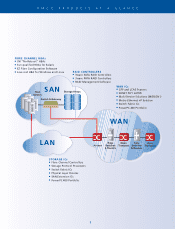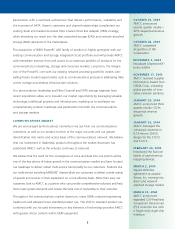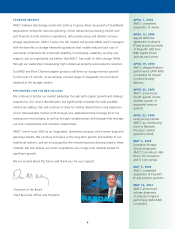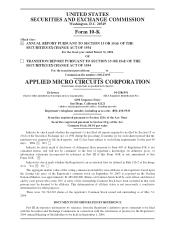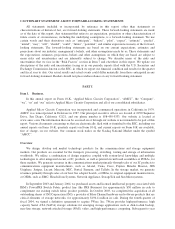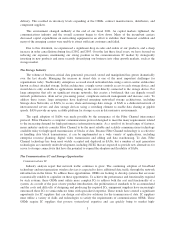3Ware 2004 Annual Report Download - page 13
Download and view the complete annual report
Please find page 13 of the 2004 3Ware annual report below. You can navigate through the pages in the report by either clicking on the pages listed below, or by using the keyword search tool below to find specific information within the annual report.Acquire Complementary Businesses, Products or Technologies
Akey element of our business strategy involves acquiring new businesses, products or technologies that
allow us to reduce the time required to develop and bring to market new technologies and products, complement
our existing product offerings, expand our market coverage, or enhance our technological capabilities. In
September 2003 and January 2004, we purchased assets and licensed intellectual property associated with IBM’s
PowerPRS Switch Fabric product line for approximately $50.0 million in cash to complement our existing switch
fabric product portfolio. In October 2003, we completed the acquisition of all of the outstanding shares of JNI
Corporation, a provider of Fibre Channel hardware and software products that are critical SAN elements, for
approximately $196.4 million in cash. In April 2004, we acquired 3ware, Inc. for approximately $145.0 million
in cash, which expanded our product offerings in the storage market. In May 2004, we purchased assets and
licensed intellectual property associated with IBM’s 400 series of embedded PowerPC standard products for
approximately $227.9 million in cash to complement our existing product portfolio in both the communications
and storage markets. We plan to continue evaluating strategic opportunities as they arise, including business
combinations, strategic relationships, capital infusions and the purchase and sale of assets.
Increase the Number of Products we Provide to Address Specific Protocols and Networking Functions
We focus our new product development efforts and acquisition activities on product lines that are
complementary to our current product portfolio in order to broaden the number of products we provide to address
specific protocols and networking functions. For example, our current product offerings include physical layer
products, overhead processor products, and higher layer products for communications applications, and HBAs
and RAID controllers for enterprise storage applications. Both communications and enterprise storage
applications may use general purpose processors, like the 400 series PowerPC processors acquired from IBM in
May 2004. We believe that we will be able to increase our sales to existing customers and increase our market
share in the communications and storage enterprise markets by taking advantage of product synergies and
integration opportunities.
Increase our Market Share in Non-Solaris Storage Environments
Our HBAs have achieved their greatest market acceptance in computing environments built with high-end
servers from Sun Microsystems due to our products’ interoperability with the Sun Solaris operating system. To
increase our revenues and grow our storage business we are focusing significant marketing and qualification
efforts on building market share with our newer products that interoperate with other operating systems.
Provide a Time-to-Market and Development Cost Advantage to Our Communications Equipment OEMs
Due to the extended downturn in the communications industry, our OEM customers have become more
efficient with their engineering resources and have significantly cut equipment development budgets. Our
strategy is to provide our customers with a complete portfolio of IC products. We believe this comprehensive
solution strategy provides our customers with guaranteed interoperability, pre-designed subsystems, better cost
economics, and system-level expertise. The result for the OEM is faster time-to-market, better performance and
lower development cost. To continue these customer benefits in future generations of products, we are pursuing
an aggressive product integration strategy to provide greater functionality in fewer ICs.
5


